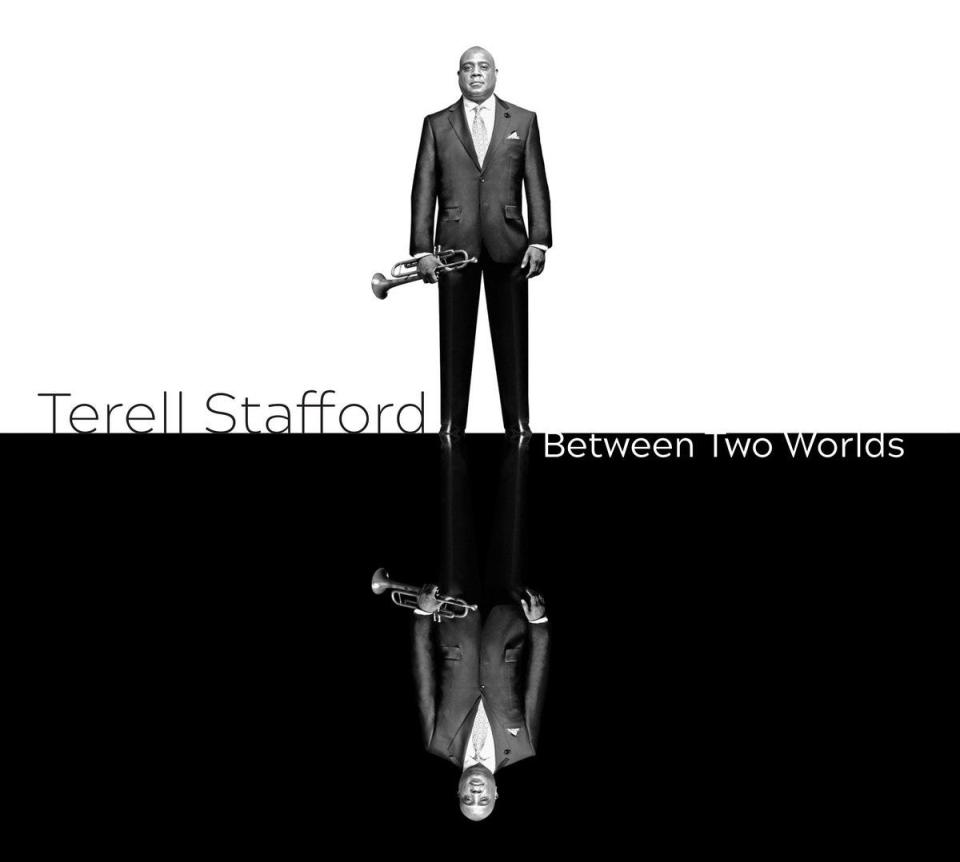Notes and tones: Trumpeter Stafford's latest beautifully navigates 'Two Worlds'
- Oops!Something went wrong.Please try again later.
- Oops!Something went wrong.Please try again later.
A long time ago, I made a conscious decision that this space would, as the clichéd line goes, “accentuate the positive.”
Still, from time to time, I try to mix it up a bit, challenge myself by selecting material from people I haven’t heard previously, know very little about — maybe don’t even recognize their names. That has always been a great part of jazz’s wonderful spirit, of its very being. Always more to explore.
Sometimes, though, it’s nice to check in with the familiar — that is, the most recent music — of people, see what they are up to. It likely means I cover said musicians in a way that kind of throws objectivity out the window. I was never a big fan of objective journalism anyway. I still think no such thing exists.
In the world of music and those who deliver the notes — stringing them together as they choose — there are only two kinds of music: good and bad. That thought may trace to Duke Ellington, who, when it comes to music, knew just what the heck he was talking about.

With that in mind, I decided to listen to trumpeter Terell Stafford’s “Between Two Worlds,” (Le Coq), released last month. Thankfully, a greater number of people continue to become familiar with and, what’s more, appreciate Stafford’s work. On this latest “chapter,” the trumpeter attempts to tackle a kind of personal dichotomy.
As Shaun Brady’s liner notes intimate, Stafford sees himself somewhat caught betwixt and between. He has a family life — including his 6-year-old daughter Mia and wife Jamie — but his professional life requires him to be away from home for chunks of time. He runs/administrates both Temple University’s jazz and classical programs, thus working in both worlds.
Then, as Brady points out, there’s the challenge of balancing his duality as a bandleader and as a “side person,” where he contributes mightily to others’ creations. “Between Both Worlds,” with its half-black, half-white cover, also sees the artist portrayed standing in two directions, the soles of his shoes seemingly touching each other.
Nonetheless, on “Between Two Worlds,” whatever “crisis” — my word, not Stafford’s — the trumpeter might be addressing inwardly and/or outwardly doesn’t negatively impact the music he and his cohorts offer up.
Rather, we have Stafford calling upon his go-to quintet, a serious bunch of talented players who know each other well on and off the bandstand. It’s not inaccurate in the slightest bit that Stafford thinks of his bandmates as his family, or other family.
How can one not love a lineup that includes front-line colleague Tim Warfield Jr. on tenor and soprano saxophones, and an impeccable rhythm section comprised of top-to-bottom prowess with pianist Bruce Barth, bassist David Wong and drummer Johnathan Blake. And, just for grins, add veteran percussionist Alex Acuña to the mix. Ouch!
Give or take, “Between Two Worlds” runs 64 minutes; it’s a full and varied sounding set of nine pieces, with Stafford paying homage to a number of people.
For starters, the opening selection and title track is composed by drummer Victor Lewis, who has written beautiful music for as long as I’ve listened to him. Not surprisingly, Stafford, who has known Lewis since at least the time they played together as members of Bobby Watson and Horizon, does this burner justice, with monster solos arriving at every turn.
There are interpretations of a pair of pianists’ repertoire, both who influenced him — especially McCoy Tyner, who Stafford worked with, and whose mid-tempo ballad “You Taught My Heart To Sing” allows for emotional honestly throughout, capped by an unaccompanied trumpet solo toward the end of the piece.
The other pianist referenced here is Horace Silver and, not surprisingly, an energetic reading of his “Room 608” takes place; presented as almost a kind of hard-bop throwback — straight-ahead, a bit of soulfulness and a subtle Latin tinge — the reading, at junctures, owns a Sonny Rollins, calypso-flavored feel.
There are numerous pleasing originals here. “Mi a Mia,” a Stafford piece for his daughter, offers another fun-filled Latin-infused entry that is followed by the quiet “Two Hearts As One,” an ode to his wife. In contrast to its predecessor, this romantic ballad is driven by Stafford’s muted trumpet and Wong’s bow work.
Stafford has always taken a liking to Billy Strayhorn’s music. In 2011, he released the critically acclaimed “This Side of Strayhorn” (MAXJAZZ), an endeavor comprised of the namesake’s compositions. On “Between,” Barth has arranged Strayhorn’s complex and pensive “Blood Count” for the group as well as composing and arranging his airy-sounding “Manaus at Dusk.”
Stafford and Co. close with “Wruth’s Blues,” the trumpeter’s blues-drenched depiction of his mother, who apparently was wondering when she would receive an original composed in her honor. This 9-minute exposition brings on reminiscences of the tough tenors, Depression-era stomps and the like.
For this bunch, it’s essentially the equivalent of the proverbial 83 mile-per-hour batting practice fastball, read home run, which seems like a fitting conclusion to Mr. Stafford’s latest.
Jon W. Poses is executive director of the “We Always Swing” Jazz Series. Reach him at jazznbsbl@socket.net.
This article originally appeared on Columbia Daily Tribune: Notes and tones: Trumpeter Stafford's latest beautifully navigates 'Two Worlds'

